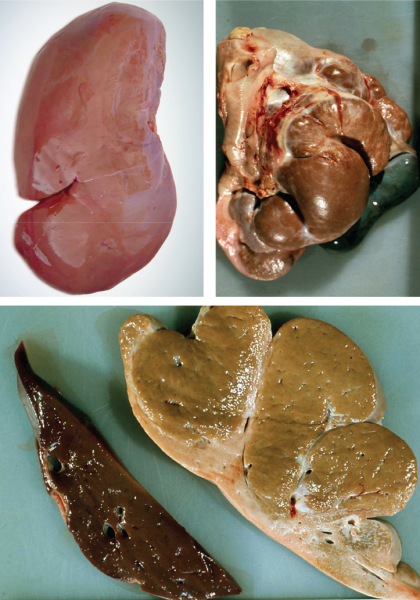
The Spores
Facial Eczema (FE) is a disease of the liver that occurs as a result of ingesting spores containing the mycotoxin Sporidesmin. These spores are produced by the fungus Pseudopithomyces toxicarius which grows on dead and dying pasture litter when moisture and temperatures are favorable.

The Liver
Sporidesmin attacks the cells in the bile duct which impairs the liver’s capacity to detoxify and excrete waste products. One of these, phytoporphyrin, a breakdown product of the green pigment in plants, chlorophyll, accumulates in various body tissues, including skin, making the animal sensitive to sunlight. UV radiation then causes immediate and extremely intense sunburn in poorly or non-pigmented parts of the body. The destructive effects on the bile ducts and liver cells c cause death as a result of liver failure. Fortunately, at low levels of FE challenge, most affected animals will survive and recover thanks to the liver’s enormous potential for repair and regeneration, but production will be seriously reduced in the short term.

Top left and right shows a healthy liver compared to a liver affected by FE. Bottom shows a healthy cross section of a liver compared to a liver affected by FE.
The Conditions
Pseudopithomyces toxicarius spores grow quickly in dead or dying grass litter typically found in the base of pasture during summer and autumn months when conditions are more favourable for spore development.
This is usually towards the end of January or early February, but especially when the nights become warm and humid (>12°C), or a dry period is followed by rain. However, a slow build-up of spores and continual exposure over a period of time will also result in similar risk levels.
Misconceptions
Facial Eczema (FE) is seasonal and only occurs from February to March
- Spores can be at damaging levels from December right through until June.
Heavy rain will decrease rise
- For a short period but counts can rise rapidly if the conditions are right.
Frosts kill off the spores
- Fungal colonies are able to continue producing spores after frosts. Cold intensifies the toxicity of the sporidesmin.
- If the climatic conditions warm up again the risk will still be present.
Not on my farm
- If spore counts are high in the region spore counts are very likely to be present on all farms.
- Every paddock may vary in counts, whether you have short or long grass. There can be sub-clinical losses, even if you don’t see any clinical signs.
Only counts >50,000 cause damage
- Continuous exposure to spore counts as low as 20,000 can cause as much damage as short spikes.
Black cattle don’t get FE
- Yes they do – it’s a liver disease; black cattle may not exhibit pigmentation and skin peeling.
FE spores only grow during periods of high humidity, light rain, grass minimum >12-13°C & high ground temperatures
- They must have dead and dying pasture litter to grow on and can still grow when air temps are <12°C.
Only rye grass pastures pose high risk
- High risk factors are rye grass, cocksfoot, browntop, yorkshire fog pastures, and around urine patches (FE spores are known to be nitrophillic).
Fungicides kill all spores
- This only applies when fungicide is applied at the right time. When the pasture is green and growing and counts are less than <20,000 – check before grazing.
Cows get sufficient zinc from water trough treatment
- Studies have shown that individual cow zinc levels can vary considerably, dependent on the volume of water drunk or zinc supplemented feed eaten.






